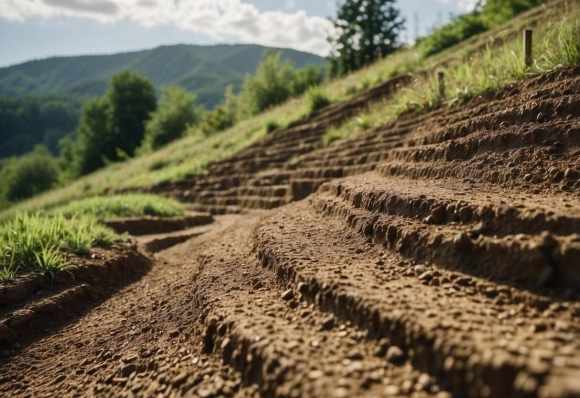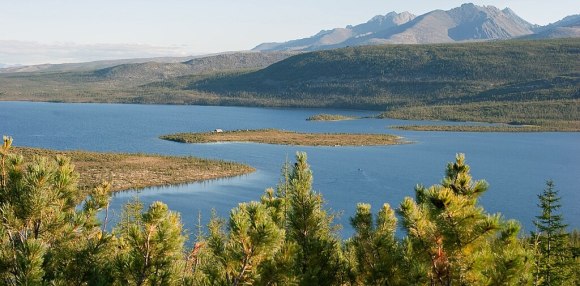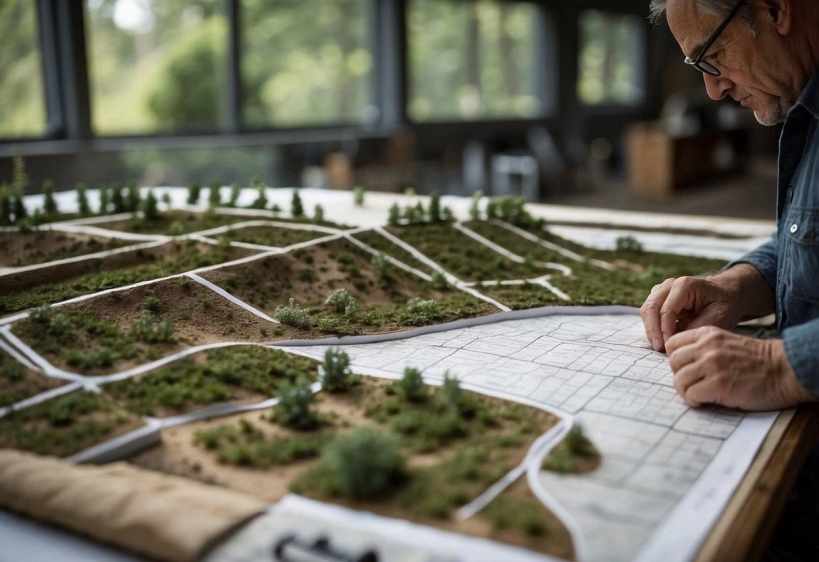Erosion control plans are crucial for managing the environmental impact of construction activities, particularly in areas prone to soil displacement. A well-developed erosion control plan helps prevent soil erosion and sediment runoff, protecting both the construction site and the surrounding environment. These plans are usually designed and handled by professionals like Erizon Queensland to mitigate the effects of wind and water erosion on exposed soil, which is a common issue during construction projects.
Effective erosion management involves implementing various control measures such as sediment traps, mulch banks, and sediment fencing. These methods are strategically placed to minimise soil loss and sedimentation that can pollute local waterways. Construction sites that follow these guidelines ensure compliance with regulatory standards and contribute to the sustainability of natural ecosystems.
For small-scale builders and developers working on projects less than 2,500m2, understanding and following the updated guidelines on erosion and sediment control can make a significant difference. By planning early and incorporating erosion control measures into their development applications, they can maintain site integrity and safeguard the environment from unnecessary damage.
Fundamentals of Erosion and Sedimentation

Soil erosion and sedimentation are critical environmental issues with significant impacts on water quality and construction projects. Understanding how these processes work is vital to developing effective control plans.
Understanding Soil Erosion
Soil erosion is the process of soil particles being detached and moved by natural forces such as water and wind. It often begins with raindrop impact, which loosens the soil, enabling surface runoff to carry it away. The severity of soil erosion depends on factors like soil type, slope gradient, vegetation cover, and rainfall intensity.
When vegetation is sparse, soil erosion can escalate, leading to significant loss of topsoil. This process not only degrades the soil’s fertility but also contributes to sedimentation in nearby water bodies. Proper vegetation cover and the use of erosion control measures like mulching and contour ploughing can help reduce soil erosion.
Consequences of Sedimentation
Sedimentation occurs when eroded soil particles settle in a new location, often in water bodies like rivers, lakes, and reservoirs. This can result from natural events or human activities, such as construction and deforestation. Sedimentation affects water quality by increasing turbidity, reducing sunlight penetration, and disrupting aquatic habitats.
Excessive sedimentation can clog waterways, decrease water storage capacity, and increase the risk of flooding. It can also transport pollutants attached to soil particles, leading to further environmental degradation. Effective sediment control measures, such as sediment fences, sediment traps, and proper site planning, are essential in mitigating the adverse effects of sedimentation.
Understanding these fundamentals is crucial for developing strategies to prevent soil erosion and manage sedimentation efficiently. By implementing best practices, it is possible to protect soil health and maintain water quality.
Strategies in Erosion and Sediment Control

Effective erosion and sediment control strategies hinge on thoughtful planning, best management practices, and specific measures to control sediment. It is crucial to adopt a comprehensive approach that addresses each aspect diligently to prevent environmental degradation.
Design Considerations
When developing an erosion and sediment control plan, site-specific factors are paramount. Factors such as topography, soil type, and rainfall patterns influence how erosion occurs and must be integrated into the design.
Vegetation plays a vital role in stabilising soil. Selecting appropriate plant species helps reduce erosion while providing aesthetic and ecological benefits. Grasses, shrubs, and trees with extensive root systems can effectively anchor the soil.
Drainage design is another critical consideration. Properly designed drainage systems, including swales and retention basins, manage runoff and minimise erosion. Implementating safe and effective runoff control prevents erosion and protects surrounding landscapes.
Best Management Practices

Best Management Practices (BMPs) are essential in managing erosion and sediment in construction sites. Silt fences are a widely used BMP that serve as a barrier to prevent sediment from leaving the site.
Mulching and erosion control blankets provide immediate soil cover. These materials protect the soil from wind and water erosion, maintaining its integrity until vegetation establishes.
Sediment traps and sediment basins are effective in capturing sediment from runoff. These structures are particularly effective for larger construction sites where significant soil disturbance occurs.
Regular maintenance and monitoring ensure BMPs function correctly. Inspections after significant weather events allow for prompt adjustments and repairs, ensuring ongoing effectiveness.
Sediment Control Measures
Sediment control measures target the capture and containment of sediment on construction sites. Sediment barriers like fiber rolls or silt socks are flexible options that can be placed along slopes or around drain inlets.
Sediment ponds are designed to collect runoff and allow sediment to settle before water is discharged from the site. These ponds require periodic dredging to maintain capacity and effectiveness.
Stormwater inlet protection prevents sediment from entering drainage systems. Using geotextile fabric or gravel bags around inlets can significantly reduce sediment load in stormwater systems.
Stabilised construction entrances are crucial for minimising soil tracked off-site by vehicles. They typically consist of large aggregate layers that remove sediment from vehicle tyres before they leave the site.
By integrating these strategies, construction sites can minimise erosion and sedimentation, protecting waterways and preserving surrounding landscapes.
Developing an Erosion Control Plan

Creating an effective erosion control plan requires a structured approach that includes careful site assessment, focused drafting, and proper implementation and approval. Attention to detail in each phase ensures compliance with regulations and minimises environmental impact.
Assessment and Planning
A thorough assessment of the site is the first critical step in developing an erosion control plan. This involves identifying potential areas prone to erosion and understanding site-specific factors such as soil type, slope, and climate conditions.
Soil testing helps determine the soil’s susceptibility to erosion, while mapping the site provides a clear view of vulnerable areas. Climate data, such as rainfall patterns, is crucial for anticipating water flow and sediment displacement.
Drafting the Control Plan
The drafting phase involves outlining specific measures to control erosion and sedimentation. These measures can include sediment fences, mulch banks, and other barriers placed strategically to mitigate runoff.
Additionally, the plan should detail the installation of sediment traps and temporary stabilization processes, such as grass seeding or mulching, to protect exposed soil. Each method should be chosen based on effectiveness and suitability for the site conditions.
Approval and Implementation
Once drafted, the plan must undergo a review and approval process with relevant authorities to ensure compliance with environmental regulations. This step involves submitting detailed documentation and possibly revising the plan according to feedback from regulatory bodies.
Upon approval, implementation begins. Proper execution requires on-site monitoring to ensure all control measures are installed correctly and function as intended. Regular maintenance and adjustments may be necessary to adapt to changing site conditions and project progress.
Regulatory Compliance and Maintenance

Ensuring regulatory compliance and adopting effective maintenance practices are essential in developing and implementing erosion control plans. This involves securing necessary permits, conducting frequent inspections, and employing ongoing maintenance to manage erosion risks from land-disturbing activities.
Permits and Inspections
Obtaining the correct permits is crucial before any land-disturbing activity commences. Municipalities and other local governing bodies typically require approval for Erosion and Sediment Control Plans (ESCP) to ensure that projects meet environmental standards.
Regular inspections are necessary to verify that erosion control measures are functioning correctly. These inspections may be mandated by local regulations, especially for developments beyond a specific size, and are critical in avoiding fines and project delays. Inspectors look for compliance with approved plans and the effectiveness of the installed control measures.
Ongoing Maintenance Practices
Routine maintenance of erosion control measures prevents failures and mitigates erosion risks throughout the project’s life cycle. This can include cleaning sediment traps, repairing silt fences, and maintaining stabilised site access points.
A proactive approach involves regular site assessments to identify emerging erosion issues early. Maintenance activities should be documented and scheduled to ensure consistent implementation. Effective practices not only protect the soil and water but also contribute to the long-term sustainability of the infrastructure being developed.



Leave a Reply